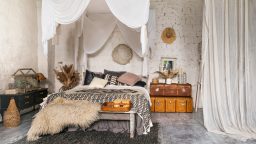Mastering how to style open shelving in kitchen spaces is all about creating a balance between practicality and beauty. Open shelves can make a kitchen feel brighter, more spacious and more personal, but only when the items displayed are chosen intentionally. With thoughtful styling, open shelving becomes one of the most charming and functional design features in your home.
Start by choosing a cohesive colour palette. When shelves are exposed, visual harmony matters more than ever. Stick to two or three dominant tones that complement your cabinetry and countertops — for example, warm neutrals paired with soft greens, or crisp whites combined with natural wood. A tight colour palette keeps the shelves from looking cluttered and helps everything feel curated.
Function should guide your first layer of styling. Place everyday essentials — plates, bowls, glasses and mugs — on the lower shelves where they’re easy to reach. Opt for matching sets or similar shapes to maintain visual consistency. If your dishes vary in colour, group them in coordinated stacks so they appear intentional rather than random.
When learning how to style open shelving in kitchen, consider mixing materials for depth. Combine ceramics, wood, glass and metal to create a dynamic, layered look. Glassware adds lightness, wooden cutting boards introduce warmth, and ceramic bowls or jars provide structure. Using a blend of textures prevents the shelves from feeling flat while keeping the style airy and modern.
Decorative elements elevate the design without overwhelming it. A few potted herbs, a small trailing plant or a vase with fresh greenery soften the straight lines of shelves and bring natural movement into the kitchen. Vintage pieces like old jugs, rustic crocks or antique jars add charm and character. Keep decorative items minimal so the shelves remain functional.
Varying height is key to a polished composition. Combine tall items like pitchers with medium pieces such as stacked bowls and smaller details like salt cellars or spice jars. Height variation gives the shelves a natural rhythm and prevents the eye from stopping abruptly. You can also lean a framed print or wooden board at the back to add subtle layers without taking up much space.
Storage containers keep the shelves tidy. Glass jars with wooden or metal lids make everyday cooking ingredients look stylish and organised. Use them to store pasta, rice, spices or baking essentials. Consistent jar shapes and labels bring clarity and reduce visual noise. Baskets or woven bins placed on higher shelves can hide less aesthetic items while still contributing to a cohesive look.
Placement matters just as much as what you display. Leave some breathing room between clusters so the arrangement doesn’t feel overcrowded. Think in small groupings of two or three items rather than long lines. Position items slightly off-centre and mix vertical stacks with horizontal ones to create a balanced but natural composition.
Lighting enhances the beauty of open shelving. If possible, install soft under-shelf lighting or position the shelves where natural light highlights their contents. Warm lighting makes ceramics glow, glass sparkle and wooden accents feel richer. Even without built-in lights, placing reflective items like glass bottles or polished utensils can brighten the shelves.
Keep practicality at the heart of your styling. Items you use often should remain accessible, while decorative accents can sit slightly higher. Rotate seasonal pieces or switch out greenery to keep the shelves feeling fresh. If you love variety, maintain a flexible arrangement that’s easy to update without needing a full overhaul.
Ultimately, mastering how to style open shelving in kitchen design is about blending everyday usefulness with a thoughtful, curated aesthetic. When items are grouped with intention, colours remain consistent and textures are layered softly, open shelves become a beautiful extension of your kitchen rather than a clutter magnet.
A well-styled set of shelves adds personality, warmth and charm to the room you use most. Take your time experimenting with arrangements until the shelves feel balanced and inviting, and if you ever need help coordinating colours or choosing the right containers, a kitchen design specialist can guide you with confidence.





